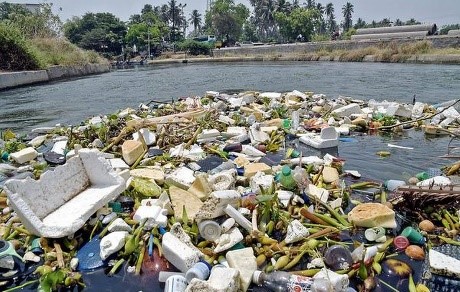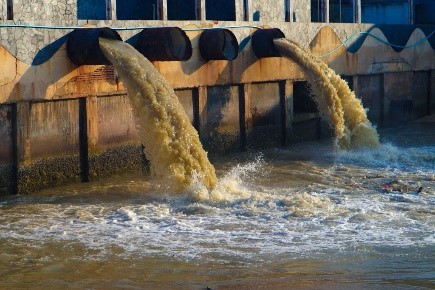




What Are the Main Categories of Industrial Waste in Chemistry?
The rapid growth of population and urbanisation has been accompanied by an increase in industrialisation and waste generation. Waste is a substance or material which is unwanted and unusable. Some common sources of waste are houses, industries, factories, agricultural wastes, etc. Many wastes are dumped in an environment where it causes pollution in the environment. Waste could be solid, liquid, or gas. There are many types of sources based on which municipal waste is composed of household waste and commercial waste. Hazardous waste and biomedical wastes include industrial waste and clinical waste, respectively. Waste such as radioactive waste, explosive waste, and electronic waste (e-waste) fall into the category of Special hazardous. These wastes are polluting the environment and causing various diseases.
Industrial Waste and Its Types
Industrial wastes are generated by manufacturing, industrial processes, mills and mining processes. Industrial wastes are majorly responsible for the pollution of water bodies such as a river, lakes, coastal waters, etc. Dirt and gravel, metals, trash, oil, solvents, textile mills, metal industry, wastewater from pulp and paper mills, chemicals, waste from food processing industries, and other similar wastes are examples of industrial wastes. It also affects the aesthetic quality of water bodies. Industrial waste is also causing harm to water bodies and aquatic life. These industrial wastes are disposed of mainly from small industries as these industries are unable to invest in waste management intervention. Industrial waste is sometimes also referred to as solid industrial waste.
There are two types of industrial waste biodegradable and non-biodegradable:
Biodegradable Industrial Waste:
These wastes are decomposable and not harmful to the environment. Waste such as food by-products from the food processing industry, wool, animal bones from the slaughterhouse, dairy, wastewater from textile mills, house wastes, etc. are included in industrial wastes, which can be decomposed into less harmful material by the action of certain microbes are the biodegradable wastes. These wastes are less toxic in nature and can be treated easily; no special method is required for conversion. Some biodegradable waste decomposes itself depending on the material, and other wastes which need interventions for treatment are combustion, composting, gasification, bio-methanation, etc.
Non-Biodegradable Waste:
Non-biodegradable wastes include which is not decomposable on their own or from the microorganism. These types of waste are more harmful to the environment and human life. Industrial wastes such as plastic, metal, pesticides, chemical, glass, etc., are not decomposable. When the quantity of it increases in the environment, it is more prone to cause air, water and soil pollution and health hazards. Management and treatment of non-biodegradable industrial waste are very expensive.
Industrial Waste Pictures
Some pictures of industrial waste are given below:

Industrial Waste

Industrial Waste
Industrial Waste Examples
The aquaculture industry has increased boomingly in the last decades so has the waste generated from it. Aquaculture sludge and wastewater have increased. Wastewater from aquaculture includes suspended solids, nitrogen and phosphorus compounds.
Milk industry waste includes sludge and whey wastewater. This waste includes increased BOD and COD values. Agro-industrial waste includes waste used during the agriculture process, including chemicals, pesticides, or fertilisers and also some useful byproducts such as sugarcane bagasse, wheat and rice bran, corn cob, etc.
Tannery waste and the leather industry include waste such as cow dung, leaf litter, skin, hide byproducts, etc. Tannery industries also produce wastewater with high COD and BOD.
Industrial Wastes Pollution
Industrial waste has caused harmful effects and pollution in the environment. Industrial wastewater can cause pollution such as water, air and soil. Wastewater from the tannery, milk, and aquaculture industry has caused increased water pollution. By-product gases from the industrial process are harmful to the environment and cause air pollution. Which in turn is responsible for the emergence of various diseases related to the respiratory system.
Solid waste from industries is dumped on land, which causes pollution to the soil. Soil pollution decreases the fertile land. Specifically, non-biodegradable wastes are even more dangerous and harmful for both the environment and humans.
Industrial Garbage
Industrial waste is referred to as industrial garbage. This garbage is dumped on the ground, and it's increasing day by day. Proper management of this industrial garbage is very difficult and expensive. If the management is not done properly, it may cause severe effects and pollution. Industrial garbage is mainly responsible for land or soil pollution, thereby increasing the chance of an increase in harmful substances and gases in water.
Green dustbins are used for eco-friendly biodegradable waste collection. Whereas blue dustbins are used for non-biodegradable waste collection like metals and glass.
Key Features of Industrial Ways and Their Type
Increase in population globalisation; urbanisation has increased industrialisation to fulfil the need of the increasing population.
Increased industrialisation is associated with increased industrial waste. Industrial wastes are of two types biodegradable and non-biodegradable.
The main source of industrial waste is the paper and pulp industry, tannery, dairy industry, contruction, etc. These wastes are responsible for causing soil, water and air pollution.
FAQs on Types of Industrial Waste Explained with Examples
1. What exactly is defined as industrial waste?
Industrial waste refers to the unwanted or unusable materials generated as a direct by-product of manufacturing, mining, and various industrial processes. Unlike household waste, it often contains specific and potentially hazardous components related to the industry of origin, such as chemical solvents, heavy metals, or organic sludge.
2. What are the two primary classifications of industrial waste?
Based on their ability to decompose naturally, industrial wastes are primarily classified into two main types:
- Biodegradable Waste: This type can be broken down into simpler, harmless substances by microorganisms like bacteria and fungi. Examples include waste from food processing industries, paper mills, and textile factories.
- Non-biodegradable Waste: This type cannot be decomposed by natural processes and persists in the environment for very long periods, causing long-term pollution. Examples include plastics, synthetic fibres, toxic chemicals, and metal scraps.
3. Can you provide some common examples of waste from different industrial sectors?
Yes, different industrial sectors produce unique types of waste. Common examples include:
- Tannery & Leather Industry: Wastewater with high levels of chromium, animal hides, sludge, and chemical residues.
- Paper and Pulp Industry: Lignin, wood chips, and wastewater containing chlorine and other bleaching agents.
- Food Processing Industry: Organic sludge, whey wastewater from dairies, and by-products like sugarcane bagasse.
- Chemical Industry: A wide range of hazardous materials, including acids, alkalis, solvents, and pesticides.
4. How does industrial waste lead to environmental pollution?
Industrial waste is a major contributor to environmental degradation in several ways:
- Water Pollution: The discharge of untreated liquid effluents into rivers and lakes increases the Biochemical Oxygen Demand (BOD) and Chemical Oxygen Demand (COD), which depletes oxygen and harms aquatic life.
- Soil Pollution: The improper dumping of solid and hazardous waste on land contaminates the soil, reduces its fertility, and can lead to toxic substances leaching into groundwater.
- Air Pollution: Many industries release harmful gases like sulphur dioxide and carbon monoxide, along with particulate matter, from chimneys and manufacturing processes, contributing to air pollution and respiratory diseases.
5. How is industrial waste fundamentally different from the waste generated in our homes?
The primary difference lies in their composition and concentration. While household (municipal) waste is largely organic material, paper, and plastic, industrial waste is often more chemically complex and hazardous. It is also generated in much larger, concentrated volumes at a single source, requiring specialised and more rigorous treatment methods compared to municipal waste management systems.
6. What is the significance of BOD and COD when analysing water pollution from industrial waste?
Biochemical Oxygen Demand (BOD) and Chemical Oxygen Demand (COD) are critical parameters for measuring water pollution. BOD indicates the amount of oxygen required by bacteria to decompose the organic waste present in water. A high BOD, common in wastewater from dairies or sugar industries, signifies severe organic pollution that can deplete oxygen and kill fish. COD measures the oxygen required to chemically oxidise all organic and inorganic pollutants, providing a broader measure of water contamination.
7. Why is source segregation considered a critical first step in managing industrial waste?
Segregating industrial waste at its source is critical because it prevents cross-contamination. When hazardous waste is mixed with non-hazardous waste, the entire volume must often be treated as hazardous, dramatically increasing disposal costs and complexity. Source segregation allows for the efficient recycling of materials like metals, composting of biodegradable matter, and the isolated, safe disposal of truly toxic substances, making the entire management process more sustainable and economical.
8. Why is waste from small-scale industries often a greater environmental concern than from large corporations?
Waste from small-scale industries is a major concern because they often lack the financial resources and technical infrastructure for proper waste management. Unlike large corporations that can invest in dedicated effluent treatment plants (ETPs), smaller units may dispose of their waste improperly—often in municipal dumps or local water bodies—leading to widespread, unregulated pollution that is difficult to trace and control.
























